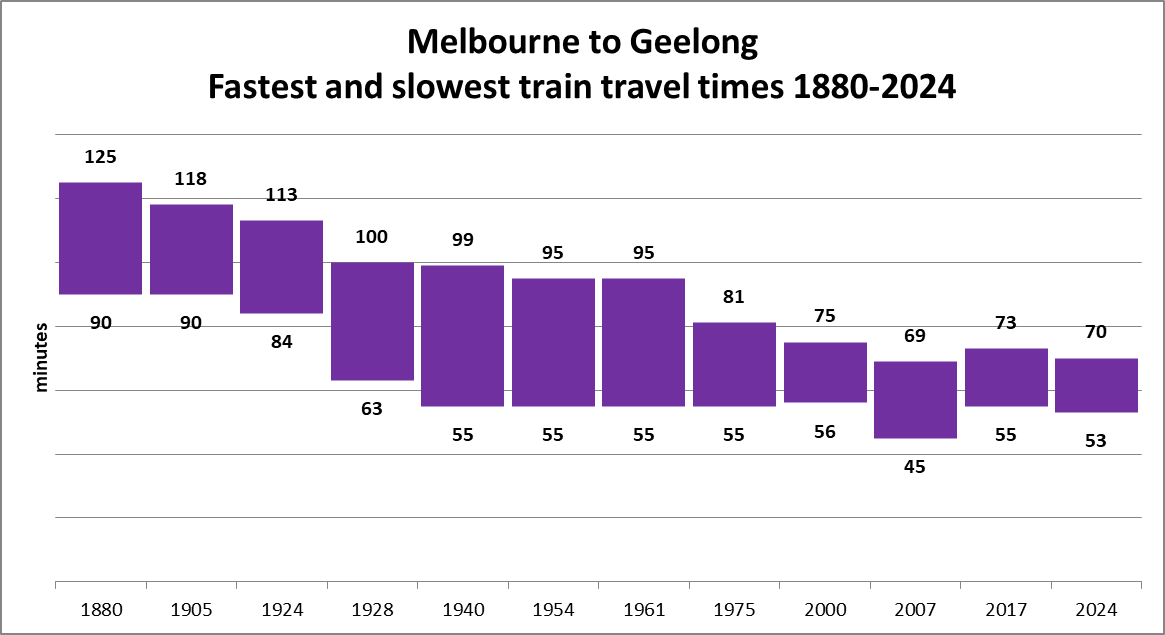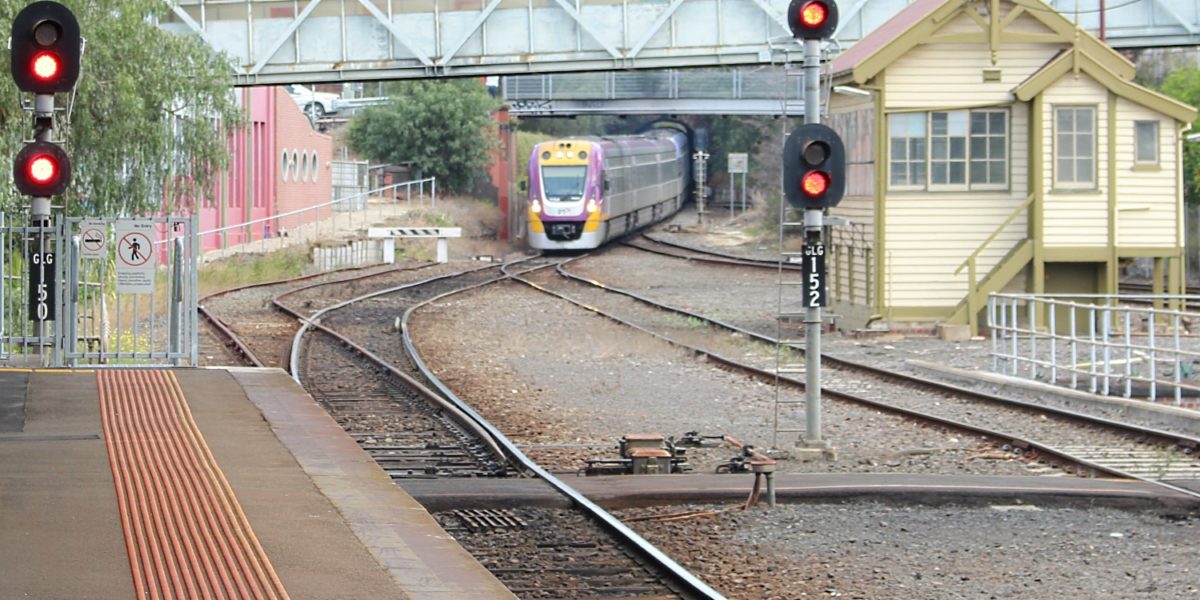PAEC (Public Accounts and Estimates Committee) can be quite useful at highlighting serious issues, but some of it is just pointless politicking. Government MPs often ask Dorothy Dixers. Opposition MPs often just try to go for the jugular. It’s often the Crossbench MPs who ask the most useful questions – though to be fair sometimes the Government and Opposition do too.
At the recent PAEC Budget Estimates hearings, the myth of trains being faster last century than now came up again.
Bev McARTHUR: At the moment the current V/Line timetable has Geelong trains running at a similar time to some trains in the 1940s when they were steam-hauled. I mean, Cobb & Co springs to mind here. How can you be going backwards in travel times? … they are running slower in many cases than they were in the 1940s.
PAEC, 20/5/2024, hearing with the Minister for Public Transport
Judging from the transcript, the Minister and the Departmental staff weren’t ready with a clear answer, but ALP MP Michael Galea, also a member of the committee, picked up on the false premise of the question.
After the hearing, even people who should know better, like Matthew Guy, Opposition Public Transport Spokesperson, repeated the claim. (His post included some wording gymnastics, including a typo, which makes me suspect he knew full well it wasn’t really true.)
Here’s a chart showing slowest and fastest train times, an expansion from a previous comparison, using a range of old timetables found online (many on the victorianrailways.net web site) to provide a comparison not just between 1940 and 2024, but over a longer time period.

Hopefully this chart makes it pretty clear that there’s been steady improvements in travel times over the years.
If speed is the only thing you care about, then 2007 is your sweet spot; the 17:29 train from Melbourne to Geelong did it in 45 minutes, with stops only at North Melbourne and North Geelong.
This was just after the Regional Fast Rail upgrades, so trains had sped up, but before patronage growth really necessitated a lot more trains on the Werribee and Geelong lines, slowing things down a bit. And before RRL changed the line to a longer route.
Admittedly the fastest journey time hasn’t vastly improved since 1940, but today in 2024, there’s about six times as many trains each day, and the line is longer, via Deer Park and Wyndham Vale, serving more stations and more people (and providing more capacity to the busy Werribee line).
Could they run a train faster than 53 minutes today? Yes – but they’d have to clear the tracks of other trains ahead of it by cutting services to some of V/Line’s busiest stations to get it through more quickly. Not a good idea.
Even with modern day constraints, the fastest train in 2024 is faster than in 1940, and the slowest train in 2024 is much faster than in 1940, by some 29 minutes.
Of course all this is based on the timetable – we don’t know how often the trains were on time in 1940 – I wouldn’t want to make any assumptions without evidence. In May 2024, punctuality on the Geelong line was 90.1%.
Some people yearn for the good old days. But rose-tinted glasses mislead. And in many ways, things have improved. Geelong line train speeds certainly have.
And bringing this false claim up again and again distracts from the actual problems, like frequency, reliability, capacity and crowding – especially since last year’s fare changes.
- Memo to self: the chart is a variation on an Average-Min-Max chart, done in Excel
- I think I’ve checked all the fastest and slowest times, but if you see any errors, please leave a comment.
- Many moons ago, Michael Galea was on the PTUA committee for a couple of years, though I don’t recall ever talking to him about this type of claim.


10 replies on “The train speed myth (again)”
The morning train to Warrnambool is 5 minutes slower getting to Geelong today compared to the Flyer in 1940, which was the fastest train – but it does stop at Footscray and of course goes via the RRL track. I imagine this service could/should/would be sped up when it is replaced by a V/Locity, assuming the same stopping pattern.
Past Geelong, there is no comparison – the Flyer took 3:53 to get to Warrnambool from Geelong, whereas today’s takes 2:31, a 35% improvement but of course it stops at fewer stations.
An excellent graph, but it’s a bit misleading in that, from 1926 until the late 1960s, the fastest Melbourne-Geelong journey time was run by The Flier, which ran only once daily (except Sundays), and served no other stations. Almost all other Geelong line trains took around an hour and a half to make the journey. So it would be clearer if some “weighting” was incorporated into the graph.
The 2007 17:29 “flagship” VLocity service struggled to achieve the timetabled 45-minute schedule. However, the current 53-minute journey time for the 17:29 down train, which stops at four wayside stations, could only be dreamed of in the steam era.
yes @Paul, maybe one day I’ll calculate the average and/or median times, because yes they would show a better representation of the timing for typical trains most often used by people.
That said, I’m assuming the Flyer was very popular. Travel patterns were presumably quite different back then, with fewer people travelling between Geelong and Melbourne every day, though those that did may have timed their journeys specifically for the Flyer. These days there’s trains every 10-15 minutes in peak that are about as fast – overall a far more usable service.
I’ve no idea how well patronised The Flier was, but note that it ran in what would now be called the counter-peak direction – down in the morning and up in the afternoon – so it could not have been used for commuting to Melbourne.
In 1927, it became the first leg of a Melbourne – Port Fairy service, cutting a significant 90 minutes from the previous schedule.
Also note that, according to its printed timetables, the VR always spelled the the name Flier, not Flyer.
Some years ago I found some patronage records for the Geelong line for 1953 (I can’t recall where and sadly I didn’t note down my source). I’ve uploaded them at https://atfot.wordpress.com/wp-content/uploads/2024/07/geelong-timetable-and-patronage-may-1953.pdf
The Geelong Flier (the outbound 08:25 departure) carried 244 passengers on average. The PM peak departure was much more popular, averaging 452 passengers. For reference, a 6-car VLocity train seats around 430 to 440 people.
@Alan, great find – thanks!
Thanks for the snapshot of timetables and patronage. The difference between the patronage of the down Flier in the morning and the up Flier in the afternoon is remarkable, and I can’t immediately think of a reason for it.
Your timetable summary shows that there were two express trains which could have served people wanting to travel in the “peak direction” during the week – to Melbourne in the morning (0740) and from from Melbourne in the afternoon (1710). However, of course, they didn’t serve any other stations, apart from Werribee in the morning, for some reason.
I think the Tarneit link project was seriously flawed by trying to mash together two quite different goals:
– serve new suburban development at Tarneit
– provide fast rail to Geelong
Which ended up achieving neither goal very well.
As a suburban service it’s not particularly functional: limited capacity using Vlocity trains that I assume are expensive to operate; poor access leading to long dwell times; poor city connections because of terminating at Southern Cross and no stop at North Melbourne.
As fast rail to Geelong, it’s just not very fast, considering the billions that were spent on making the line 8km longer (!).
The current most common time to Geelong (about an hour) could have been equalled, no doubt at hugely less expense, by simply electrifying the existing line and extending the Werribee trains to Geelong.
I think it would have been a much better outcome, probably at much less cost, to build a suburban electric branch line to Wyndham Vale, omit the section beyond Wyndham Vale, and electrify the Werribee- Geelong line.
@Paul, note that my PDF only shows outbound patronage data from May 1953. You’d need to find patronage stats from the up Flier from other resources (maybe PROV would have it).
@Alan. Ah … thanks.
Another thing about The Flier was that, while it was a valuable innovation in a number of ways, in order to facilitate its non-stop rapid passage, any other traffic on the largely single Geelong line could not run or had to be “put away”. It also affected traffic on the relevant suburban lines.